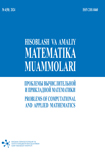Morphological analysis of nouns in English to Uzbek machine translation
Keywords:
natural language processing, noun category, word weight, plural affix, tokenizationAbstract
The article analyzes the work done so far to create a high-quality computer translation. It also describes the approaches, challenges, and solutions in achieving semantically accurate translation in computer translation. The article highlights the importance of formalization in modeling grammatical categories for English and Uzbek languages, especially the classification of nouns when they enter syntactic relationships. The significance of the morpho analyzer in ensuring accurate and high-quality automatic translation is analyzed using mathematical models and the classification of word and plural affixes and their weights in both languages. New mathematical models built for both languages are presented in separate tables for each type of noun category. The article provides explanations based on the new mathematical models constructed.
References
Lin L., Liu J., Zhang X., Liang X. 2021. Automatic translation of spoken English based on improved machine learning algorithm // Journal of Intelligent & Fuzzy Systems.– Vol. 40, ›2.– P. 2385–2395.– doi: http://dx.doi.org/10.3233/JIFS-189234.
Zhang G. 2022. Research on the efficiency of intelligent algorithm for English speech recog nition and sentence translation // Inform An Int J Comput Inform.– Vol. 45, ›2.– P. 309–314.– doi: http://dx.doi.org/10.31449/inf.v45i2.3564.
Wen H. 2020. Intelligent English translation mobile platform and recognition system based on support vector machine // Journal of Intelligent & Fuzzy Systems.– Vol. 38, ›153. P. 1-12.– doi: http://dx.doi.org/10.3233/JIFS-179788.
Dandapat S., Federmann C. 2018. Iterative data augmentation for neural machine transla tion: a low resource case study for English-Telugu // Vol. Proceedings of the 21st Annual Conference of the European Association for Machine Translation, (Alacant, Spain), Euro pean Association for Machine Translation. may 28-30,– P. 287–292.
Lin X, Liu J, Zhang J, Lim S. 2020. A novel beam search to improve neural machine translation for English-Chinese // Comput Mater Contin (Engl).– Vol.65,– ›1– P. 387–404. doi: http://dx.doi.org/10.32604/cmc.2020.010984.
Luong MT, Manning CD. 2016. Achieving open vocabulary neural machine translation with hybrid word-character models // Proceedings of the 54th Annual Meeting of the As sociation for Computational Linguistics, (Berlin, Germany), Association for Computational Linguistics.– Vol.1,– P. 1054–1063. doi: http://dx.doi.org/10.18653/v1/P16-1100.
Choi H, Cho K, Bengio Y. 2017. Context-dependent word representation for neural machine translation // Comput Speech Lang.– Vol.45,– P. 149–160. doi: http://dx.doi.org/10. 1016/j.csl.2017.01.007. doi: http://dx.doi.org/10.18653/v1/P16-1100.
Marchuk Yu.N. 2010. Translation models: textbook.aid for student institutions of higher education // Publishing Center “Academy”.– 176 p.
Novikov I.A. 1983. Semantics of the and its formalization // M. Science,– 216 p.
Abdurakhmonova N. 2017. Representation morphological analysis in machine translation // O’zbekistonda xorijiy tillar ilmiy metodik elektron jurnal.– Vol.40,– ›2,– 13 p.
Xakimov M.X. 2019. Texnologiya mnogoyazikovogo modeliruemogo kompyuternogo perevodchika // Monografiya. LAP LAMBERT. Academic Publishing, Riga.– 174 p.
Xakimov M.X. 2009. Rasshiryaemiy vxodnoy yazik matematicheskogo modelirovaniya estesstvennogo yazika dlya mnogoyazichnoy situasii mashinnogo perevoda // O’zMU xabar lari.– P. 75–80.
Khakimov M.Kh., Sirojiddinov Z.Sh. 2021. Computer algorithmization in multi-language modelled translator technology // Modern problems of applied mathematics and information technologies al-Khwarizmi.–– 2 p.





